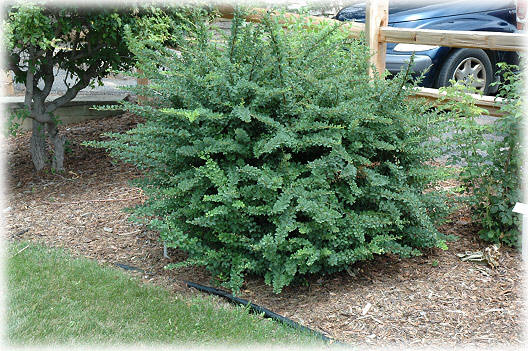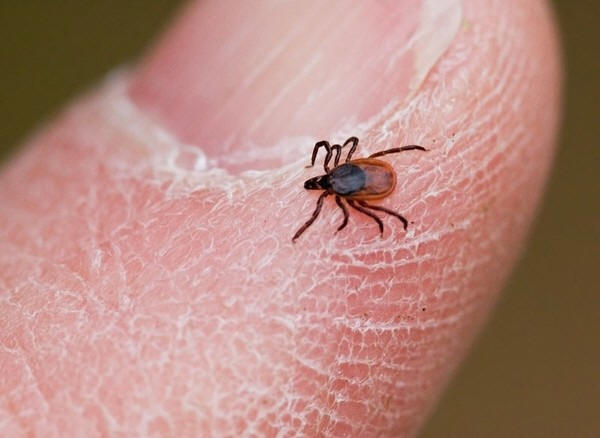You may recall that deer tick abundance is a
relatively new phenomenon here in the North Woods. These ticks are
VERY little – about the size of a freckle or a speck of pepper. In
just the past decade, reports of deer ticks (different from the
common wood tick) by Ottawa Forest employees have risen
dramatically, from one or two a year for all employees at the
Bessemer Ranger District to multiple deer ticks per day, and
sometimes, per employee.
Other than the annoyance of an itchy bite and the revolting image of
being eaten, deer ticks are the primary vector of illnesses such as
Lyme disease. As the name suggests, deer are a primary host of adult
deer ticks. Given the abundance of deer in the northeastern and
Midwestern US, it isn’t surprising then, that Lyme disease (named
for the Connecticut town where it was first diagnosed) and two other
deer tick-caused illnesses are worst in those parts of the county.
Last year, nearly 3100 cases of Lyme disease in Connecticut alone
caused symptoms ranging from flu-like fever, chills, headache, and
muscle aches to nerve damage and arthritis.
For the past 5 years, Connecticut researchers have been studying the
relationship between Japanese barberry, deer ticks, and deer. Why?
Because folks had started to notice that Japanese barberry thickets
create a moist, cool, microclimate near the ground that favors ticks
– a tick ‘nursery’, if you will. In contrast, hot, dry conditions
suppress ticks; the amount of snowfall has no effect.
Looking at 28 study sites, results from the first two years show
that larval ticks and adult tick populations are highest in high
density barberry sites. The highest incidence of Lyme
disease-carrying ticks is also in high density barberry. After
removal, the infection rate of Lyme significantly lessened the
second year, becoming equal to areas without any Japanese barberry.
Although additional research will continue, the early results
(published in Environmental Entomology, 2009) indicate that Japanese
barberry infestations threaten humans by creating a favorable
environment for ticks. High populations of ticks leads to an
increase in the incidence of Lyme disease.
Prickly, Tick-ly Menace
For years, Japanese barberry (Berberis thunbergii) has been on
Federal and State lists of invasive exotic plants. Nonetheless, it
is still freely marketed and an approved landscaping plant in many
jurisdictions.
Japanese barberry was introduced to America as a landscaping plant
more than 100 years ago. It has attractive red berries in the fall
and small oval leaves in green, red, or purple. Its thorny branches
make an effective natural fence. As recently as 2004, nearly $5
million worth of the plants were sold commercially in the US.
The berries are the source of the problem: they are a popular food
of birds, deer, and small animals, with seeds that rapidly spread in
their waste. Eaten by, say a robin in your yard, barberry seeds are
apt to be pooped someplace else, like in the woods of your neighbor.
In short order, this prolific plant can form dense canopies that
crowd and shade-out most other plants and eventually, wildlife.
The result is a monoculture forest – no wildflowers, no other
shrubs, sometimes, no maple saplings. Ponds and lakes surrounded by
dense barberry have diminished water quality, too, because the
micro-ecosystem created by the barberry results in more soil erosion
than areas with native trees and shrubs. And while deer eat, and
thus spread the seeds over great distances, they don’t care for the
prickly plant, so it thrives in the face of deer (over)abundance.
Options
At least one 5-acre patch of woods on the Bessemer District has been
dominated by barberry for the past several years. There’s another
infestation of similar size on a private woodlot just outside
Bessemer.
For land managers, private or public, tackling this persistent shrub
is a major challenge, especially with limited budgets and labor
pools composed mostly of volunteers. Removal in the woods tends to
be a two-step process, beginning with mechanical removal (shovel,
chainsaw, or bulldozer), and followed by application of an herbicide
or burning. Backyard options include pulling them up (gloves
strongly recommended!) and/or spraying them.
After initial eradication, a return check is needed every year or so
to prevent re-growth.
Of course, not planting any more barberry and replacing existing
ones with something else, like witch alder (Fothergilla gardenia),
would be even better. Perhaps you could talk to a neighbor if he/she
has barberry at their home. If that neighbor is us – the Ottawa
National Forest – we’d like to know too; report barberry sightings
to Forest Botanist Ian Shackleford at 932-1330 x331.
Last year, some Connecticut businesses finally agreed to a voluntary
phase-out of 25 varieties of barberry that are the most highly
prolific and invasive. But the phase-out doesn’t [yet?] apply to
mail-orders or other States. Botanists are hoping its role as a host
for tick populations will provide the necessary motivation.
As one researcher put it, removing barberry is no longer important
just because it's non-native; “by controlling barberry, he said, you
can have a real impact on human health."
Hoping to see YOU, not barberry or ticks, in the woods.
________________________________________
MELANIE B. FULLMAN
Bessemer District Ranger, Ottawa NF
906-932-1330 x539; cell: 906-364-0413
E6248 US Hwy. 2; Ironwood, MI 49938
|

